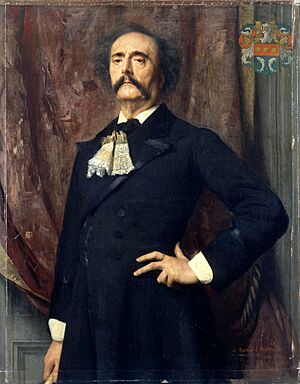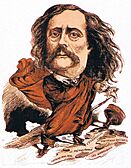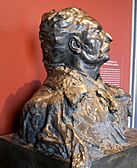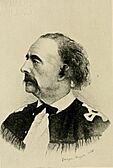Jules Barbey d'Aurevilly facts for kids
Quick facts for kids
Barbey d'Aurevilly
|
|
|---|---|

Portrait by Émile Lévy, 1882.
|
|
| Born | Jules Amédée Barbey 2 November 1808 Saint-Sauveur-le-Vicomte, Normandy, French Empire |
| Died | 23 April 1889 (aged 80) Paris, French Republic |
| Resting place | Saint-Sauveur-le-Vicomte |
| Occupation | Novelist, essayist, critic |
| Period | 1825–1889 |
| Literary movement | Realism, Decadence, "Dandyism" |
| Notable works | Les Diaboliques |
| Signature | |
 |
|
Jules-Amédée Barbey d'Aurevilly (born November 2, 1808 – died April 23, 1889) was a famous French writer. He wrote novels, poems, short stories, and worked as a literary critic. He was known for his mystery stories that looked into people's hidden thoughts and feelings. His stories often hinted at dark themes without being about ghosts or magic. He greatly influenced other well-known writers like Henry James and Marcel Proust.
About Jules-Amédée Barbey d'Aurevilly
Jules-Amédée Barbey was born in Saint-Sauveur-le-Vicomte, a town in Normandy, France. The "d'Aurevilly" part of his name came from an uncle later on.
When he was 19, in 1827, he went to Collège Stanislas de Paris to study. After finishing school in 1829, he studied law at Caen University and got his degree three years later.
When he was young, Barbey d'Aurevilly had very modern ideas. He believed in liberalism, which supports individual rights and freedoms. He was also an atheist, meaning he didn't believe in God. His early writings showed religion as something that just made things more complicated for people.
However, in the early 1840s, his views changed. He started visiting a special gathering place called a salon. This salon was hosted by Baronne Almaury de Maistre, who was a Catholic and supported the old royal family (a "legitimist"). In 1846, Barbey d'Aurevilly became a Catholic.
His most successful writing career began in 1852. He became an important literary critic for a newspaper called Le Pays. He helped bring attention back to writers like Balzac and promoted others like Stendhal, Flaubert, and Baudelaire.
Barbey d'Aurevilly was famous for creating his own unique image. He was a "dandy," which meant he dressed very stylishly and acted in an aristocratic way. He often hinted at a mysterious past, even though he came from a normal, well-off family and had a calm childhood. He loved the area of Valognes in Normandy, and many of his stories are set among the noble families of that region. Even though he didn't write in the local Norman language, his work helped bring back interest in local literature in Normandy.
Jules-Amédée Barbey d'Aurevilly passed away in Paris. He was first buried in the Montparnasse Cemetery. Later, in 1926, his remains were moved to the churchyard in his hometown of Saint-Sauveur-le-Vicomte.
His Written Works
Barbey d'Aurevilly wrote many different kinds of books, including novels, essays, and poems.
Fiction (Stories)
- Le Cachet d'Onyx (1831)
- Léa (1832)
- L'Amour Impossible (1841)
- La Bague d'Annibal (1842)
- Une vieille maîtresse (A Former Mistress, 1851)
- L'Ensorcelée (The Bewitched, 1852)
- Le Chevalier Des Touches (1863)
- Un Prêtre Marié (1864)
- Les Diaboliques (The She-Devils, 1874; a collection of short stories)
- Une Histoire sans Nom (The Story Without a Name, 1882)
- Ce qui ne Meurt Pas (What Never Dies, 1884)
Essays and Criticism (Non-Fiction)
- Á Rebours (1884)
- Du Dandysme et de Georges Brummel (The Anatomy of Dandyism, 1845)
- Les Prophètes du Passé (1851)
- Les Oeuvres et les Hommes (1860–1909)
- Les Quarante Médaillons de l'Académie (1864)
- Les Ridicules du Temps (1883)
- Pensées Détachées (1889)
- Fragments sur les Femmes (1889)
- Polémiques d'hier (1889)
- Dernières Polémiques (1891)
- Goethe et Diderot (1913)
- L'Europe des Écrivains (2000)
- Le Traité de la Princesse ou la Princesse Maltraitée (2012)
Poetry
- Ode aux Héros des Thermopyles (1825)
- Poussières (1854)
- Amaïdée (1889)
- Rythmes Oubliés (1897)
Translated into English
- The Story without a Name. (1891, translated by Edgar Saltus)
- The Story without a Name. (1919)
- Of Dandyism and of George Brummell. (1897, translated by Douglas Ainslie)
- Dandyism. (1988)
- Weird Women: Being a Literal Translation of "Les Diaboliques". (1900)
- The Diaboliques. (1925, translated by Ernest Boyd)
- "Happiness in Crime." (1946)
- The She-devils. (1964, translated by Jean Kimber)
- What Never Dies: A Romance. (1902)
- What Never Dies: A Romance. (1933)
- Bewitched. (1928, translated by Louise Collier Willcox)
His complete works are published in two large books called the Bibliothèque de la Pléiade.
Famous Sayings
Here are some interesting quotes from Barbey d'Aurevilly:
- "Next to the wound, what women make best is the bandage."
- "Books must be set against books, as poisons against poisons."
- "When superior men are mistaken they are superior in that as in all else. They see more falsely than small or mediocre minds."
- "The most beautiful destiny: to have genius and be obscure."
Gallery
-
Portrait bust of Barbey d'Aurevilly, by Auguste Rodin, 1909.
-
Barbey d'Aurevilly, by Félix Nadar.
See also
 In Spanish: Jules Barbey d'Aurevilly para niños
In Spanish: Jules Barbey d'Aurevilly para niños






